
Eigg Series. No 17. Acrylic on 5×5″ wood (Not for sale)
Today’s painting – one of Eigg’s many primroses…
These cheerful spring wild-flowers are in abundance on the island and seem an appropriate choice for today’s subject; the 1996 community buy out of Eigg, which earned world-wide renown in the late 90s as an example of positive and successful land reform
Every year the Eigg community celebrates the buy-out with an anniversary Ceilidh, it means a lot to islanders, and it’s an inspiring story. So I decided to get in touch with Maggie Fyffe, Administrator of the Eigg Heritage Trust, to find out more …

Photograph © Keith Brame
Rose: Hi Maggie, When I arrived on Eigg this year, it was only when I chatted with Lucy Conway that I realised we were staying in your bothy and you were just across the road! But after a few days on the island you realise what a close-knit, friendly community it is.
I recently read your article which described the difficult conditions Eigg dwellers found themselves in before the community buy out in 1996, and looking at the island now, it’s difficult to believe (considering it was 1996 not the 18th century!) just how difficult life had become for islanders.
So firstly, some would say that living on a remote island could be a challenging lifestyle. How did you first come to the island, and what made you want to move to Eigg?
Maggie: We were living on the east coast but had always wanted to live on the west coast. We were involved with a craft workshop near Portsoy – Keith Schellenberg visited & expressed his interest in setting up something similar on Eigg – he offered us a job & the rest is history! (that was 1976)
Rose: Can you tell me what you do now on Eigg?
Maggie: I’m employed by Isle of Eigg Heritage Trust as administration secretary. This involves doing accounts & paperwork for IEHT and its 3 subsidiary companies, Eigg Trading, Eigg Construction & Eigg Electric. I’m also voluntary treasurer for Eigg Residents Association & Eigg Community Hall.
R: Can you tell me a little more about that time back then, how was it for islanders and what were the issues they faced?
M: Most of the indigenous islanders lived on crofts so had security but anyone working for the estate lived in a tied cottage & felt insecure
R: What was it that made islanders distrust or become frustrated with landowners over the years, can you give a few examples of their approach to caring for the island?
M: It’s hard to explain – but mostly because of the unwillingness to grant leases on houses & businesses. One catalyst was (Landowner) Keith Schellenberg trying to evict the Carr family (who had five children) and the Scottish Wildlife Trust warden, John Chester – the community was in agreement that we couldn’t let that happen.
This was followed by Maruma (the second landowner) purchasing the island; after the initial reaction of “cautiously optimistic” it soon became apparent that he didn’t have the money to make the improvements he’d suggested
R: What would you say was the turning point from hoping landowners might live up to promises, to deciding to go it alone as a community?
M: Although it had been talked about – the turning point came when the original Eigg Trust (a group of 4 people connected to Eigg with an interest in land reform) brought their ideas for a buy out for the community’s consideration. A vote of all residents was held with the result of a big majority in favour of supporting this.
R: What was the response to that decision, from landowners, other trusts and the media in general?
M: We had some negative press but in the main, we received a lot of support from the media
R: I’ve read that the the island was valued at 2 million. How did you build support for your bid to buy the island as a community, and how was money raised?
M: We received somewhere in the region of 10,000 donations from members of the general public (only £17K was received from public bodies) including one donation of £1m!
R: Can you tell me a bit about the bidding process, the outcome and how you and the islanders felt after the result?
M: In November 96, our initial bid of £1.2m (based on an independent valuation & all the money we had raised) was rejected as it didn’t reach the £2m asking price. We carried on fundraising & by the following March, we decided to submit a further bid of £1.5m – this was what Maruma had paid for the island & we were unwilling to exceed this amount on principle.
It was at this point that we discovered that Maruma had defaulted on a loan & his creditors had taken over the sale. After a nerve-racking week, they eventually accepted our offer on 4th April 97 and islanders were jubilant!
R: Would you say there’s a definite difference in Eigg since the buy out?
M: It’s the difference between night & day. To name but a few…all trust properties now have long term tenants (with long term leases) and 3 farms also have appropriate leases. 7 houses have been renovated. We have built An Laimhrig which houses a shop, tearoom, craft shop all of which are leased to residents to run as their own business. We have initiated an ongoing forestry project with all the work being done by local folk.
We have installed an award winning renewable energy system which with 24 hour power has improved life no end. And the population has increased from 63 in 1997 to 96 in 2014 with a lot of our young folk moving back to live.
R: Lastly, would you say the experience changed you as a person? If so in what ways?
M: I used to be a craft worker & would never have guessed that I would end up being an admin secretary ~ a job that can be quite taxing at times but incredibly rewarding ~ every day is different. You’ll maybe need to ask someone else about how I’ve changed but I’m incredibly proud of what the community here has achieved…
R: Thank you Maggie for sharing the inspiring story of Eigg’s community buy out. And (though I’m over a decade late in saying this!); congratulations to the islanders on all they’ve achieved for the island and its inhabitants.
In the next few weeks I’ll post more information about the island moving to renewable, environmentally friendly energy..
And lastly – for further reading about Eigg and the Hebrides, a book by Alastair McIntosh ‘Soil and Soul – People Versus Corporate Power‘ is available Here
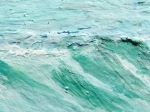 A peaceful wave in the rain on Singing Sands Bay. The rain was very light so there was a lovely soft glow over everything. I usually use gesso for a semi opaque rainy haze.
A peaceful wave in the rain on Singing Sands Bay. The rain was very light so there was a lovely soft glow over everything. I usually use gesso for a semi opaque rainy haze.



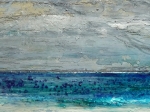

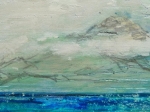






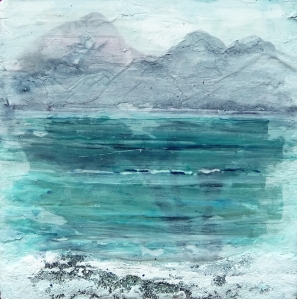












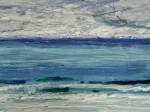





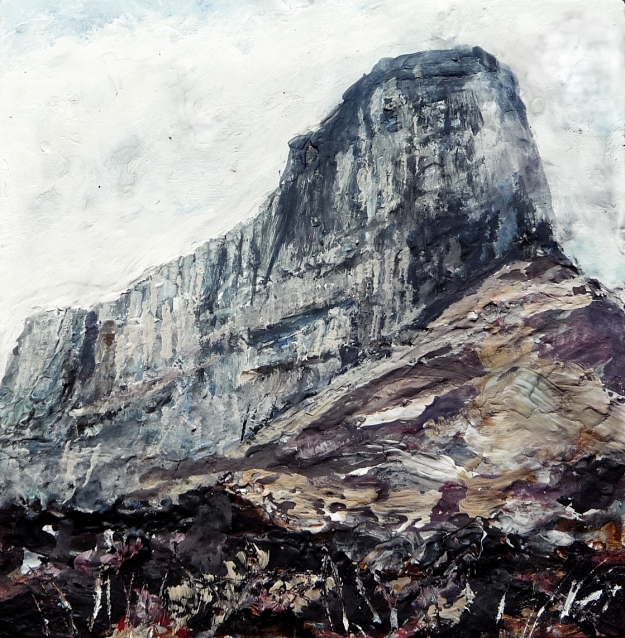

 now the Isle of Rum) erupted across the landscape, creating plateaus of basalt which now form most of Eigg.
now the Isle of Rum) erupted across the landscape, creating plateaus of basalt which now form most of Eigg.

















